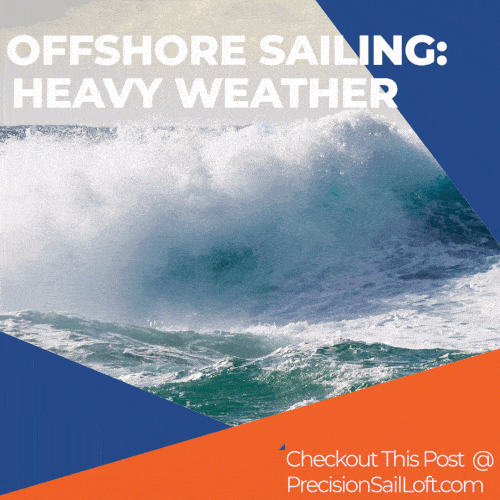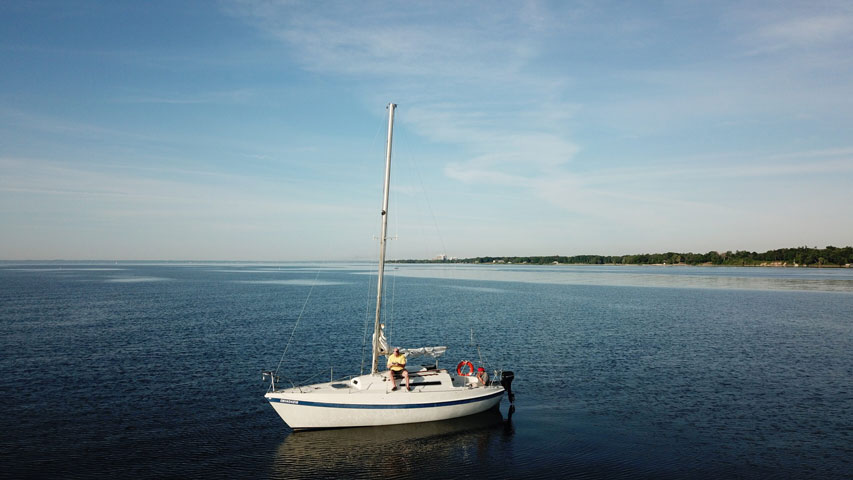
Heavy Weather Safety
Very few people get the opportunity to experience the full force of a storm at sea, its immense power, undeniable dominance, and majestic grandeur. For many sailors, the fear of heavy storms is one of their greatest sources of apprehension on the water. With fear comes panic, and panic can lead to errors in a critical situation. By learning how to safely handle your vessel in these conditions can give you the confidence to overcome this fear, ultimately seeing the storm not as an ordeal but simply an opportunity to sail in different conditions.
We will be discussing the best methods to handle your boat safely in foul weather conditions while sailing offshore, the first points of discussion are passage planning and prior preparations.
Passage Planning
Avoiding adverse weather conditions is always the best approach when sailing offshore. With advances in modern technology and accessibility to accurate weather forecasts, it is rare to come across a big storm that is completely unannounced. But as with any activity that is reliant on something as fickle as the weather it is important to be vigilant.
Despite even the most favorable forecast for your sail, passage planning must always include a Plan B. Ideally finding reliable “boltholes” to ride out poor weather. It is important to note that whilst it might be your first instinct to drop the sails and motor to shore, it may not always be your safest option if you don’t have ample time to outrun the storm. Strong winds can quickly turn shallow ground and narrow channels into a far more dangerous place than the open water, with minimal room to maneuver and a higher chance of losing control in steep onshore waves.
The other option is to make yourself familiar with the open water along your sailing route. Noting any possible hazards like markers, shallow ground, rocky outcrops, or busy shipping channels. Finding areas of uninterrupted sea room could one day come in handy should you have to outrun, or run off a storm or even just heave-to to gain some short respite and reassess the situation.
Downloading wind and polar data in addition to having maps and satellite images of your route and destination available on hand will make a world of difference and should be a standard process for any offshore passage. A variety of apps are available that are able to do a combination of these.
Similarly, identifying your weather window is needed so that you can be fully stocked and have your projects completed on time.
Prior Preparations
Before heading out on any voyage its always best to familiarize yourself with your vessel no matter how recently you were last onboard. Checking the boat’s status and managing all the critical systems, as well as taking inventory of adequate spare parts and tools.
Ensure you have all the necessary safety equipment on board; PFD’s, safety harnesses, waterproof torches, marine EPIRB, personal locator beacon (PLB), life raft, grab bag, and maybe even satellite communication for those sailing offshore. Carrying wet weather gear is essential for staying warm and dry in heavy weather conditions and is also the easiest way to keep morale high.
If you have commenced your sail and find yourself in the imminent path of some heavy weather the following are some prior preparations that should be considered before any action takes place;
- Confirm all crew members are wearing PFDs, wet weather gear and safety harnesses
- Ensure everything is securely stowed above and below deck and hatches are closed
- As the captain, delegate duties appropriate to skill level and outline your sailing strategy
- Make sure flashlights, tools and spare gear are at the ready
- Plot your position using every means at your disposal
A few hours of heavy weather sailing will always teach you far more than hundreds of miles under sail in calm seas. But learning the skills to cope with these conditions will ease your fears, transmitting cool confidence to your crew helping them to adopt the same calm attitude toward a potentially stressful situation. There is no need to fear the seas, but rather to see it as a unique opportunity we are given as sailors, to gain a deeper respect for the force of nature and all of its power.
Heavy Weather Sail Configurations
Heavy weather sailing tactics are all about balancing the power of the weather with the capabilities of your vessel. As wind forces rise exponentially it is essential to be ahead of the game. Preparing your vessel before the strongest weather arrives means that you remain in control of the boat, there is less strain on the rigging, and most importantly you and the crew remain safe. Similarly, preparing your sails to take on the reliability requirements for offshore sailing starts with their design and reinforcements.
Sail Configurations
To retain the control you want to reduce your overall sail area, so your first option is to reef the sails. Ideally, this should be done before you even think you need to. Reefing early when it is easy, rather than late which can be difficult and dangerous.
If your sail inventory allows, storm sails are a great option to have onboard. Whilst storm trysails and storm jibs may look like tiny handkerchiefs compared to the rest of your sails they are made from heavy grade fabric and are reinforced to be capable of handling heavier winds. Their design will provide far superior durability than a furled jib and reefed main and will protect your sails from becoming damaged or irregularly stretched.
Storm trysails can either be trimmed to the rail or set to the boom with a separate track so it is always bagged and ready to go.
The storm jib should be set forward of the mast to create maximum stability both laterally and with forward momentum holding course.
Progressively reducing your sail area further, your third and final sail configuration option is bare poles, running no sails at all.
If you are doing smaller trips you won’t have multiple sails in your inventory. When doing offshore/longer trips you should have a second sail onboard. This way if anything goes wrong you have a second sail to help stabilize and power up your boat.
Sail Upwind
Conditions, where it is possible to actively sail upwind, can allow for steady controlled progress provided your crew doesn’t mind some compromise on the overall comfort onboard. As with all sailing tactics for heavy weather, reducing you sail progressively as the weather requires will be essential. A well-trimmed reefed vessel can provide much better speed, higher pointing ability, and more control at the helm.
You can gain more control by pointing higher however you will put more strain on the crew and your rig which can make the situation more difficult to handle. Obviously for some cruising catamarans sailing upwind is not as achievable but your main focus should always be maintaining control and sustaining a moderate speed. Perhaps this could mean an increased angle to the wind and using some engine power on the leeside to hold the heading and create forward momentum.
Sail Downwind
Sailing downwind is often the most comfortable option as you are likely to feel the full force of the wind since you are traveling with the wind, decreasing the apparent wind speed. But as swells increase your greatest risk is losing control of steering as you surf down the waves. Mono-hull and catamarans will have various angles to take the waves downwind dependent on the scenario, regardless, you will know based on the feel and control of the boat if you are going too far downwind. This is something that takes time and practice to learn and is not recommended unless you have the experience and confidence to carry it out.
If you are running both a furled jib and mainsail it is best to use a jibe preventor. This will help keep your boom secure and prevent accidental jibes which may damage the rigging or harm a crew member. As conditions intensify it is very easy to become overpowered and there will likely be significant pressure on the mainsail against the rigging. A progressive step from here would be to run only a furled jib or storm jib. A jib flown off an inner forestay will help to retain some stability. Eventually, proceed to bare poles if the storm intensifies further using your motor to maintain control.
Heave-to
If all else fails why not just take a break and recollect your thoughts. Heaving to is when the vessel is turned close to the wind, the jib is back-winded, the helm is locked into position and the boat holds its heading without turning broadside to the waves. The boat remains pointed close enough to the wind that it is less likely to be rolled and the sliding motion of the hull creates a wake that makes it less likely for a wave to break on the boat.
Preparing A Sail Repair Kit
For anyone that does a lot of coastal cruising, bluewater sailing, or plans on doing offshore sailing a sail repair kit is a great have-to. This list is not going to cover everything you possibly could need but is a basic overview of the necessary things to have on hand.
- Sewing Machine – Be prepared to do some hand sewing. When doing long-distance bluewater sailing a lot of people will have a Sailrite portable sewing machine on hand, but not everybody has that luxury.
- Sail Palm – This allows you to push the needle through thicker fabric using your palm to apply pressure.
- Set Of pliers – This is handy to have to grab and pull the needle through the other side of the sailcloth, and for a myriad of other things on board.
- Needles And Thread – Various sizes and amounts. Breaking needles is not uncommon when hand-sewing, so it is always a good idea to have many on hand and have a variety for different thread types. Smaller needles are great for normal thread and smaller repairs, whereas a larger needle will take a waxed thread and allow you to punch through thicker materials like webbing.
- Scissors – Useful for cutting off the loose ended threads and cutting webbing/cloth.
- Sliders And Hanks – Great for replacing damaged hardware to ensure you can use your sails smoothly.
- Roll Of Webbing – Great for attaching shackles, rings, sliders, and more to your sails to keep them functioning the way they are supposed to.
- Sailcloth – Sailcloth and adhesive-backed sailcloth are great to have on board when repairing tears in your sails.
- Duct Tape – Solves a lot of issues. Who doesn’t love duct tape!


